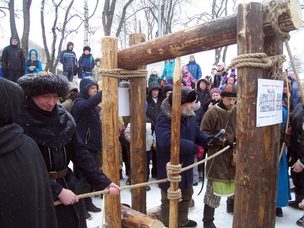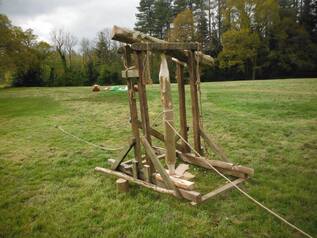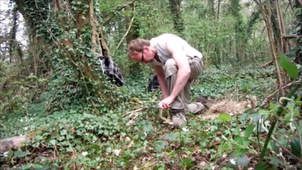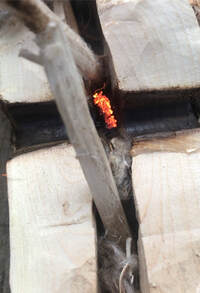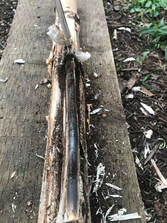Different ways of rubbing sticks.......
The way people rub sticks differs widely between modern bushcraft and survival practitioners, indigenous peoples, ritual\ceremonial practitioners, "primitive skills" practitioners etc and the SHFF approach! There is no one way to rub sticks! There are seemingly endless ways to rub sticks together! On this page I've summarised a few of the main methods - there are many variations of every method as there is always more than one way and the way a method is used may differ between culture, geography and individual etc etc. I guide people how to rub sticks for use in sacred practice.
My main methods are Neid Fire, Bow Drill, Hand Drill and Fire Plough
My main methods are Neid Fire, Bow Drill, Hand Drill and Fire Plough
Neid Fire
In 2016, I discovered Neid Fire - this was once a huge part of the cultural heritage throughout UK and Europe to ritually welcome fire and mostly buried within the ashes - erased from ancestral memory but luckily documented by 19th century historians and still used in Eastern Europe/Baltics etc. They were used at times of distress or at auspicious times of the year (such as Beltane and Samhain and Kupula Nght) to ritually welcome in a new pure fire. I will be adding more on Neid Fire as it is now my main focus to try and bring the Neid Fire back into our cultural heritage.
See the Neid Fire section
In 2016, I discovered Neid Fire - this was once a huge part of the cultural heritage throughout UK and Europe to ritually welcome fire and mostly buried within the ashes - erased from ancestral memory but luckily documented by 19th century historians and still used in Eastern Europe/Baltics etc. They were used at times of distress or at auspicious times of the year (such as Beltane and Samhain and Kupula Nght) to ritually welcome in a new pure fire. I will be adding more on Neid Fire as it is now my main focus to try and bring the Neid Fire back into our cultural heritage.
See the Neid Fire section
Fire Plough / Fire Plow
The Fire Plough is most likely one of the earliest friction methods attempted by our ancestors, due to technical simplicity i.e. literally rubbing 2 pieces of wood together! It is one of the simplest methods but not the easiest, however it is possible in the UK. For me it is a very primal way to coax fire.
It is commonly used throughout Polynesia and Australasia. Once you have the knowledge, know the technique, have the right materials and have practiced then everything is easy :) The fire plough is also mentioned in the Polynesian Maui legends. Also see these interesting articles on Polynesian fire making: http://blog.tepapa.govt.nz/2014/08/27/hika-ahi-making-fire/
nzetc.victoria.ac.nz/tm/scholarly/tei-MarYear-t1-body1-d3.html
The Fire Plough is most likely one of the earliest friction methods attempted by our ancestors, due to technical simplicity i.e. literally rubbing 2 pieces of wood together! It is one of the simplest methods but not the easiest, however it is possible in the UK. For me it is a very primal way to coax fire.
It is commonly used throughout Polynesia and Australasia. Once you have the knowledge, know the technique, have the right materials and have practiced then everything is easy :) The fire plough is also mentioned in the Polynesian Maui legends. Also see these interesting articles on Polynesian fire making: http://blog.tepapa.govt.nz/2014/08/27/hika-ahi-making-fire/
nzetc.victoria.ac.nz/tm/scholarly/tei-MarYear-t1-body1-d3.html
In June 2020 after many years of experimenting with the fire plough I finally succeeded and continued to practice and hone my approach. Since then I have been sharing the knowledge and skills I have learnt on this website, YT, and Insta.See my Fire Plough UK page for more details on how to use the Fire Plough and see below videos
|
|
|
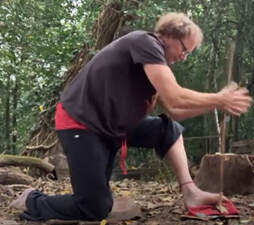
Hand Drill
The hand drill consists of a longer spindle, which is rubbed together in the hands to make it spin into a hearth board. The hand drill is the simplest technology wise of the spinning methods and I find it a very profound way to coax the embryonic fire. The spinning friction methods are a lot more effective (especially in Northern Hemisphere) as the friction energy is concentrated in one spot. Used throughout the world by many Indigenous cultures, and mentioned in many fire origin stories
See Hand Drill section for more info on using Hand Drill. People can take turns with the hand drill (like many indigenous tribes) rather than it just being the responsibility of one person.
Here are some interesting reads: Survival Skills of Native California, Fire Making Methods in the American Museum by Walter Hough
The hand drill consists of a longer spindle, which is rubbed together in the hands to make it spin into a hearth board. The hand drill is the simplest technology wise of the spinning methods and I find it a very profound way to coax the embryonic fire. The spinning friction methods are a lot more effective (especially in Northern Hemisphere) as the friction energy is concentrated in one spot. Used throughout the world by many Indigenous cultures, and mentioned in many fire origin stories
- North American Indigenous peoples primarily used the hand drill as opposed to the bow drill (see here) ; the Bow Drill was used more in the Northern regions e.g. Northern Canada and Alaska.
- The hand drill was also commonly used in South America, Africa and Australia, and it is still used by indigenous tribes today. There is also evidence in China, and is most likely the most widespread technique.
- Though there is no evidence of it's use within Europe, it does work with many native plants.
See Hand Drill section for more info on using Hand Drill. People can take turns with the hand drill (like many indigenous tribes) rather than it just being the responsibility of one person.
Here are some interesting reads: Survival Skills of Native California, Fire Making Methods in the American Museum by Walter Hough
Bow Drill
Perhaps the most widely known and used friction method especially within Northern Hemisphere and modern "Bushcraft and Survival", and the one method alot of people in the UK start learning first. Most likely, a technical advancement of the Hand Drill and it works on a much larger variation of woods than the Hand Drill in just about all environments! There are many variations of the Bow Drill
Perhaps the most widely known and used friction method especially within Northern Hemisphere and modern "Bushcraft and Survival", and the one method alot of people in the UK start learning first. Most likely, a technical advancement of the Hand Drill and it works on a much larger variation of woods than the Hand Drill in just about all environments! There are many variations of the Bow Drill
It is "believed" that the bow drill was widely used within ancient Britain and throughout the Northern Hemisphere, though there is no archaeological evidence of this.
There is evidence that the Ancient Egyptians used the bow drill and apparently they tied the cord to the drill (you can also wrap the cord multiple times instead) - this solves the slipping drill issue. The Egyptian bow drill is quite a stylised bow.
See Bow Drill section for more info. on using Bow Drill. The Bow Drill can easily be adapted to be used communally with one person holding the bearing block and two people using the bow . I commonly use the bow drill and only with natural cordage.
There is evidence that the Ancient Egyptians used the bow drill and apparently they tied the cord to the drill (you can also wrap the cord multiple times instead) - this solves the slipping drill issue. The Egyptian bow drill is quite a stylised bow.
See Bow Drill section for more info. on using Bow Drill. The Bow Drill can easily be adapted to be used communally with one person holding the bearing block and two people using the bow . I commonly use the bow drill and only with natural cordage.

Inuit Mouth Drill
The Inuits used the bow drill with a mouthpiece to decorate ivory - this freed a hand to manipulate the ivory whilst drilling. The Inuits typically used ivory and bone for the bows and skin\sinew for the cord. I am not convinced that they used the Mouth Drill for fire - the only pictures I have seen are of carving.
Me being me I did have to have a go at the the Mouth Drill and successfully coaxed an ember and I did make the below video but I must say I don't find it pleasant at all and won't be doing it again! See this blog post and below YouTube video.
The Inuits used the bow drill with a mouthpiece to decorate ivory - this freed a hand to manipulate the ivory whilst drilling. The Inuits typically used ivory and bone for the bows and skin\sinew for the cord. I am not convinced that they used the Mouth Drill for fire - the only pictures I have seen are of carving.
Me being me I did have to have a go at the the Mouth Drill and successfully coaxed an ember and I did make the below video but I must say I don't find it pleasant at all and won't be doing it again! See this blog post and below YouTube video.
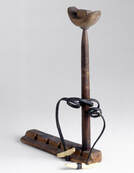
Strap Drill
The strap drill is when a piece of cord is pulled to and fro without a bow. This is usually used by a few people - drill like the Vedic Fire Churn or Celtic Fire Churn (see below.) Or you could use a mouth hold like the Inuit Mouth Drill (see picture) and use both hands to pull on the cord as your mouth is holding the bearing block.
I find strap drills do work well. (As above I do question the use of the Inuit strap drill for fire making - see this blog post.)
The strap drill is when a piece of cord is pulled to and fro without a bow. This is usually used by a few people - drill like the Vedic Fire Churn or Celtic Fire Churn (see below.) Or you could use a mouth hold like the Inuit Mouth Drill (see picture) and use both hands to pull on the cord as your mouth is holding the bearing block.
I find strap drills do work well. (As above I do question the use of the Inuit strap drill for fire making - see this blog post.)
|
Pump Drill
The pump drill was apparently used by the Iroquois amongst others. The Pump Drill - viewed as a further refinement of the Hand Drill and Bow Drill, however there is no reason why it couldn't have predated the Bow Drill and can be found in many cultures. This is still used in woodworking today for drilling holes. I had fun making and experimenting with the Pump Drill but I find it a bit too easy and mechanical! There are different variations\sizes of the Pump Drill and I've also seen a Spinning Top type version of it. |
|
The pump drill consists of a wooden spindle attached to a disc of wood or stone or clay (fly wheel.) A cross bar with a bigger hole goes onto the spindle above the flywheel with cord attached at each end which also attaches to the top of the spindle. The flywheel is wound up to wrap the cord around the spindle. The cross bar is then pumped up and down which makes the spindle spin into the hearth board. The weight of the flywheel produces momentum to keep the drill spinning. This method is supposed to create an ember much easily and quickly than the other methods. It was also used for drilling holes. A different wood\stone attachment can be added to the end of the spindle. See the video.
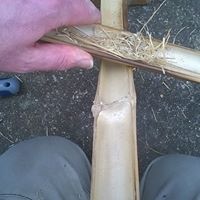
Fire Saw
The Fire Saw consists of one piece of wood being sawn across another. The Bamboo Fire Saw is used throughout Asia and I'm guessing this has been used for thousands of years. One piece of bamboo is sawed across another which has a small hole drilled through where the dust gathers and forms into an ember.
The Fire Saw consists of one piece of wood being sawn across another. The Bamboo Fire Saw is used throughout Asia and I'm guessing this has been used for thousands of years. One piece of bamboo is sawed across another which has a small hole drilled through where the dust gathers and forms into an ember.
- Australian Aborigines commonly used the fire saw (and still do today) and they also use the hand drill and bow drill. The Fire saw seemed to have been the prevalent method where bamboo could be found (e.g. throughout Asia.) It is commonly used in the Philippines.
|
In 2021, I successfully coaxed an ember using UK Native Lime on Lime (Tilia) fire saw.
I used 2 pieces of wood which I inserted 2 wood pegs to keep them separated, I stuffed willowherb within the gap and tied it together with cord. I then rubbed it up and down on top of the lime blade and the dust collected in the gap on top of the willowherb and the ember formed. The willowherb acted as an ember extender too! It does take quite a bit of experimentation to get it to work, but the fire saw can work in the UK! Again this was just a bit of "fun" and not a method I use much |
See this video on my way of trying to use the fire saw:
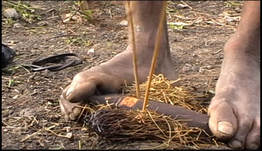
Fire Thong
The Fire Thong is used in Papa New Guinea (amongst other places) - a piece of rattan is pulled one way then the other underneath a piece of wood which has a hole all the way through . The ember forms within the hole. This is now the only main friction method that I haven't successfully coaxed an ember with (there is no rattan in the UK.)
The Fire Thong is used in Papa New Guinea (amongst other places) - a piece of rattan is pulled one way then the other underneath a piece of wood which has a hole all the way through . The ember forms within the hole. This is now the only main friction method that I haven't successfully coaxed an ember with (there is no rattan in the UK.)
|
|
Fire Roll
Another method is called the Fire Roll and also Rudiger Roll, credited to the German survivalist Rudiger Nehberg, and apparently this was first used by World War II prisoners to ignite their cigarettes. There are many YouTube videos of people using various materials for the Fire Roll. The basic concept is to roll cotton wool or dry plant fibres with ash between two flat planks of wood or stones using pressure and speed, and after time this causes friction and the fibres start to smoulder and produce an ember. I have successfully used nettle cordage as fire roll material. There is no evidence of other cultures using fire roll but who knows it could have been used long before Rudiger. |
Vedic Fire Churns
The Vedic Fire Churn as shown in the photo below right, to ritually welcome Lord Agni within the Vedic strand of Hinduism . See the Vedic Fire Churn section for more info.
The Vedic Fire Churn as shown in the photo below right, to ritually welcome Lord Agni within the Vedic strand of Hinduism . See the Vedic Fire Churn section for more info.
Other methods
There are many variations of rubbing sticks and lots of people enjoy experimenting with slight variations of these methods. There is ALWAYS more than ONE way!!!
Check out @wur_thaz_smoke , @nwprimate and @dalemgumino on Instagram and YouTube
Check out my Arm Bow Drill and Foot Fire Drill posts :) I have had fun over the years experimenting.
Also check out Phyredojo.com who has spent many years experimenting with various variations of the friction methods and has his OWN unique approach different to any other I have seen.
A couple of alternative methods :
Fire Brace - see this demo by @wur_thaz_smoke - see www.instagram.com/tv/CIcLxWXhjSM/?utm_source=ig_web_copy_link.
Fire Screw - by @dalemgumino - see https://www.instagram.com/p/CIhYt-apKr7/?utm_source=ig_web_copy_link - an ingenious creation crafted by Dalem Gumino from Bali.
Cordless Bow Drill! whatever next :) again by @dalemgumino - https://www.instagram.com/p/CPInnl2Jkyg/
Some interesting "theoretic" slavic methods can be seen here. I don't think many of these would work.
There are many variations of rubbing sticks and lots of people enjoy experimenting with slight variations of these methods. There is ALWAYS more than ONE way!!!
Check out @wur_thaz_smoke , @nwprimate and @dalemgumino on Instagram and YouTube
Check out my Arm Bow Drill and Foot Fire Drill posts :) I have had fun over the years experimenting.
Also check out Phyredojo.com who has spent many years experimenting with various variations of the friction methods and has his OWN unique approach different to any other I have seen.
A couple of alternative methods :
Fire Brace - see this demo by @wur_thaz_smoke - see www.instagram.com/tv/CIcLxWXhjSM/?utm_source=ig_web_copy_link.
Fire Screw - by @dalemgumino - see https://www.instagram.com/p/CIhYt-apKr7/?utm_source=ig_web_copy_link - an ingenious creation crafted by Dalem Gumino from Bali.
Cordless Bow Drill! whatever next :) again by @dalemgumino - https://www.instagram.com/p/CPInnl2Jkyg/
Some interesting "theoretic" slavic methods can be seen here. I don't think many of these would work.
